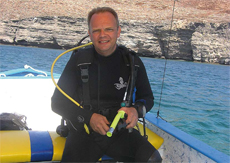




| Home | Features | Club Nights | Underwater Pics | Feedback | Non-Celebrity Diver | Events | 8 August 2025 |
| Blog | Archive | Medical FAQs | Competitions | Travel Offers | The Crew | Contact Us | MDC | LDC |

|

|
 
 |
 |
ISSUE 2 ARCHIVE - BEST DIVE, WORST DIVE, TIM ECOTTBEST: A pilot once told me that in aviation there is a saying: "any landing you can walk away from is a good landing." In that sense, then every dive from which we safely ascend to the surface is a good dive. From me, there is a simple and indescribable pleasure in simply breathing underwater – whether in a swimming pool or in a tropical sea. And, unlike some divers I know, I like looking at marine life. I have had great dives with seals in Maine, sea snakes in Fiji, sharks in Tahiti, whalesharks in Seychelles, mad Frenchmen in Réunion, humpback whales in Turks and Caicos, pygmy seahorses in Sulawesi and mating mandarin fish in Mabul. I have been thrilled in blue holes in Bahamas, and on the great wall at Bloody Bay in the Cayman Islands, electrified by a field of ghostly white tunicates off Kerry and mesmerised by orcas in a Norwegian fjord. |
 |
|
It is hard to single out a dive as the very best, but anyone who's read 'Neutral
Buoyancy' will know that I end the book with an account of a dive in Seychelles and
a remarkable encounter with a group of wild dolphins. Making eye-contact with an
intelligent species who were in their natural element (and I was not) was heartstoppingly-
moving and slightly disturbing. But what made the dive truly special was
sharing the experience with my wife, Jessica. Telling her about it afterwards would
not have been nearly as wonderful as sharing that intimate moment.
WORST: I made my very first scuba dive in the Seychelles, and loved the country so much that I moved Heaven and Earth to find a way of living there. After three years the plan came to fruition, and I was then able to spend two years living in the islands, and diving several times each week. Seychelles was something of an under-rated gem among the world's dive destinations, and although the reefs were relatively small they were bursting with life and good health. And then came the El Nino event of 1998. Most divers will know that the sea temperatures in much of the Indian Ocean reached record levels and Seychelles was dealt a cruel blow: high temperatures coincided with zero cloud cover and some of the reefs experienced water temperatures of 35°C. 90% of the hard corals bleached, and then died. I had left Seychelles by the time the coral died, but returned a year later on a reporting assignment. At Lighthouse, one of my favourite dive sites, I joined a boatload of holiday divers. I knew Lighthouse like the back of my hand, and as a divemaster had led perhaps fifty dives to the site. I got lost. Underwater, the site was unrecognisable. Not only was the coral gone, but the rubble too had been swept away by wave action, scrubbing the granite substrate as smooth as tarmac. No reef meant no butterfly fish. No reef meant no anemone sacs and no clownfish. And no turtles to feed on the soft corals and sponges. Up on the boat the divemaster asked me if I'd had a good dive. "Fine," I lied, not wanting to say anything about what the reef had been like before. "It was great wasn't it," the eager leader enthused. "So many snappers!" There were fish to see, yes, but as a newcomer to the island she did not know, could not know, what was missing. I sat on the boat in silence as we headed back to the dive centre, and felt as dispirited as if I had just been at a funeral. Was this the future of the world's reefs? That dive haunts me still, and though I have been back to Seychelles several times since, I avoid the sites I loved so well. |
 | |
Previous article « Things to do in Sharm when you're Dry Part 2 Next article » Love Being A Tender Back to Issue 2 Index | ||